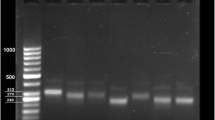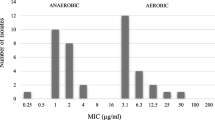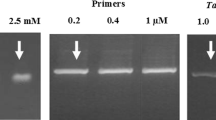Abstract
Fourteen of 28 Trichomonas vaginalis isolates collected from patients in Guangzhou, China from 2003 to 2004 were found to be naturally infected with Mycoplasma hominis, as determined by PCR using specific primers. In vitro metronidazole sensitivity assay of the 28 isolates revealed four displaying low susceptibility [minimum lethal concentration (MLC)=∼13–25 μg/ml] and another four displaying high resistance (MLC=50–100 μg/ml). The overwhelming majority of these resistant isolates (7/8) were mycoplasma-infected. The mean of MLCs of mycoplasma-infected isolates is ∼10-fold higher than the mean of noninfected isolates (p=0.029). Sequence analyses of PCR-amplified small subunit–large subunit rRNA interspacer regions (ITS1/5.8S/ITS2) revealed that 23 of the 28 samples are identical, the remaining five being separable into two groups, each with a single point mutation. These internal transcribed spacer sequence variants are associated neither with mycoplasma infection nor with drug resistance. In contrast, random amplified polymorphic DNA analyses of DNAs using 10 different primers showed that the drug-resistant isolates are clustered together in association with mycoplasma infection, albeit more loosely. Taken together, the results obtained from this study suggest that in vitro metronidazole resistance of T. vaginalis is related to mycoplasma infection of this protozoan.



Similar content being viewed by others
References
Blanchard A, Yanez A, Dybvig K, Watson HL, Griffiths G, Cassell GH (1993) Evaluation of intraspecies genetic variation within the 16S rRNA gene of Mycoplasma hominis and detection by polymerase chain reaction. J Clin Microbiol 31:1358–1361
Brown DM, Upcroft JA, Dodd HN, Chen N, Upcroft P (1999) Alternative 2-keto acid oxidoreductase activities in Trichomonas vaginalis. Mol Biochem Parasitol 98:203–214
Chakrabarti D, Dame JB, Gutell RR, Yowell CA (1992) Characterization of the rDNA unit and sequence analysis of the small subunit rRNA and 5.8S rRNA genes from Tritrichomonas foetus. Mol Biochem Parasitol 52:75–83
Clyde WA Jr, Chanock RM, Tully JG (1990) Mycoplasmas. In: Davis BD, Dulbecco R, Eisen HN, Ginsberg HS (eds) Microbiology, 4th edn. Lippincott, Philadelphia
Dessi D, Delogu G, Emonte E, Catania MR, Fiori PL, Rappelli P (2005) Long-term survival and intracellular replication of Mycoplasma hominis in Trichomonas vaginalis cells: potential role of the protozoon in transmitting bacterial infection. Infect Immun 73:1180–1186
Diamond LS (1957) The establishment of various trichomonads of animals and man in axenic cultures. J Parasitol 43:488–490
Dong Z, Hoven CW, Rosenfield A (2005) Lessons from the past. Nature 433:573–574
Dunne RL, Dunn LA, Upcroft P, O’Donoghue PJ, Upcroft JA (2003) Drug resistance in the sexually transmitted protozoan Trichomonas vaginalis. Cell Res 13:239–249
Durel P, Couture J, Bassoullet MT (1967) The rapid detection of metronidazole in urine. Br J Vener Dis 43:111–113
Edwards DI, Thompson EJ, Tomusange J, Shanson D (1979) Inactivation of metronidazole by aerobic organisms. J Antimicrob Chemother 5:315–316
Flegr J, Zaboj P, Vanacova S (1998) Correlation between aerobic and anaerobic resistance to metronidazole in trichomonads: application of a new computer program for permutation tests. Parasitol Res 84:590–592
Gunderson J, Hinkle G, Leipe D, Morrison HG, Stickel SK, Odelson DA, Breznak JA, Nerad TA, Muller M, Sogin ML (1995) Phylogeny of trichomonads inferred from small-subunit rRNA sequences. J Eukaryot Microbiol 42:411–415
Hallden C, Hansen M, Nilsson NO, Hjerdin A, Sall T (1996) Competition as a source of errors in RAPD analysis. Theor Appl Genet 93:1185–1192
Hampl V, Vanáčová Š, Kulda J, Flegr J (2001) Concordance between genetic relatedness and phenotypic similarities of Trichomonas vaginalis strains. BMC Evol Biol 1:11
Heine P, McGregor JA (1993) Trichomonas vaginalis: a reemerging pathogen. Clin Obstet Gynecol 36:137–144
Heyworth R, Simpson D, McNeillage GJ, Robertson DH, Young H (1980) Isolation of Trichomonas vaginalis resistant to metronidazole. Lancet 2:476–478
Hillis DM, Dixon MT (1991) Ribosomal DNA: molecular evolution and phylogenetic inference. Q Rev Biol 166:411–453
Ingham HR, Hall CJ, Sisson PR, Tharagonnet D, Selkon JB (1979) Inactivation of metronidazole by aerobic organisms. J Antimicrob Chemother 5:734–735
Jacobs B, Mayaud P, Changalucha J, Todd J, Ka-Gina G, Grosskurth H, Berege ZA (1997) Sexual transmission of hepatitis B in Mwanza, Tanzania. Sex Transm Dis 24:121–126
Katiyar SK, Visvesvara GS, Edlind TD (1995) Comparisons of ribosomal RNA sequences from amitochondrial protozoa: implications for processing, mRNA binding and paromomycin susceptibility. Gene 152:27–33
Kulda J, Tachezy J, Cerkasovova A (1993) In vitro induced anaerobic resistance to metronidazole in Trichomonas vaginalis. J Eukaryot Microbiol 40:262–269
Kumar S, Tamura K, Nei M (2004) MEGA3: integrated software for molecular evolutionary genetics analysis and sequence alignment. Brief Bioinform 5:150–163
Laga M, Manoka A, Kivuvu M, Malele B, Tuliza M, Nzila N, Goeman J, Behets F, Batter V, Alary M (1993) Non-ulcerative sexually transmitted diseases as risk factors for HIV-1 transmission in women: results from a cohort study. AIDS 7:95–102
Land KM, Johnson PJ (1999) Molecular basis of metronidazole resistance in pathogenic bacteria and protozoa. Drug Resist Updat 2:289–294
Lossick JG (1989) Trichomonads parasitic in man. In: Honigberg BM (ed) Therapy of urogenital trichomoniasis. Springer, Berlin Heidelberg New York
Lu H (1991) Treatment situation of vaginitis of Trichomonas vaginalis and leaf mold by Chinese traditional medicine. Acta Chinese Med Pharma 4:31–33
Lu F, Zhang D, Tian F (2004) Preliminary analysis of HIV epidemic in China. National Center for Disease Control and Prevention, Beijing
Mammen-Tobin A, Wilson JD (2005) Management of metronidazole-resistant Trichomonas vaginalis—a new approach. Int J STD AIDS 16:488–490
Mayta H, Gilman RH, Calderon MM, Gottlieb A, Soto G, Tuero I, Sanchez S, Vivar A (2000) 18S ribosomal DNA-based PCR for diagnosis of Trichomonas vaginalis. J Clin Microbiol 38:2683–2687
McFadzean JA, Pugh IM, Squires SL, Whelan JP (1969) Further observations on strain sensitivity of Trichomonas vaginalis to metronidazole. Br J Vener Dis 45:161–162
Minkoff H, Grunebaum AN, Schwarz RH, Feldman J, Cummings M, Crombleholme W, Clark L, Pringle G, McCormack WM (1984) Risk factors for prematurity and premature rupture of membranes: a prospective study of the vaginal flora in pregnancy. Am J Obstet Gynecol 150:965–972
Narcisi EM, Secor WE (1996) In vitro effect of tinidazole and furazolidone on metronidazole-resistant Trichomonas vaginalis. In vitro effect of tinidazole and furazolidone on metronidazole-resistant Trichomonas vaginalis. Antimicrob Agents Chemother 40:1121–1125
Nei M, Li WH (1979) Mathematical model for studying genetic variation in terms of restriction endonucleases. Proc Natl Acad Sci U S A 76:5269–5270
Nyirjesy P, Weitz MV, Gelone SP, Fekete T (1995) Paromomycin for nitroimidazole-resistant trichomonosis. Lancet 346:1110
Quon DV, d’Oliveira CE, Johnson PJ (1992) Reduced transcription of the ferredoxin gene in metronidazole-resistant Trichomonas vaginalis. Proc Natl Acad Sci U S A 89:4402–4406
Rappelli P, Addis MF, Carta F, Fiori PL (1998) Mycoplasma hominis parasitism of Trichomonas vaginalis. Lancet 352:1286
Rappelli P, Carta F, Delogu G, Addis MF, Dessi D, Cappuccinelli P, Fiori PL (2001) Mycoplasma hominis and Trichomonas vaginalis symbiosis: multiplicity of infection and transmissibility of M. hominis to human cells. Arch Microbiol 175:70–74
Rasoloson D, Tomkova E, Cammack R, Kulda J, Tachezy J (2001) Metronidazole-resistant strains of Trichomonas vaginalis display increased susceptibility to oxygen. Parasitology 123:45–56
Saitou N, Nei M (1987) The Neighbor-joining method: a new method for reconstruction of phylogenetics trees. Mol Biol Evol 4:406–425
Salvaggio A, Conti M, Albano A, Pianetti A, Muggiasca ML, Re M, Salvaggio L (1993) Sexual transmission of hepatitis C virus and HIV-1 infection in female intravenous drug users. Eur J Epidemiol 9:279–284
Sambrook J, Russell David W (2001) Molecular cloning: a laboratory manual, 3rd edn. Cold Spring Harbor, New York
Schmid G, Narcisi E, Mosure D, Secor WE, Higgins J, Moreno H (2001) Prevalence of metronidazole-resistant Trichomonas vaginalis in a gynecology clinic. J Reprod Med 46:545–549
Snipes LJ, Gamard PM, Narcisi EM, Beard CB, Lehmann T, Secor WE (2000) Molecular epidemiology of metronidazole resistance in a population of Trichomonas vaginalis clinical isolates. J Clin Microbiol 38:3004–3009
Sobel JD, Nagappan V, Nyirjesy P (1999) Metronidazole-resistant vaginal trichomoniasis—an emerging problem. N Engl J Med 341:292–293
Steindel M, Dias Neto E, Pinto CJ, Grisard EC, Menezes CL, Murta SM, Simpson AJ, Romanha AJ (1994) Randomly amplified polymorphic DNA (RAPD) and isoenzyme analysis of Trypanosoma rangeli strains. J Eukaryot Microbiol 41:261–267
Stellrecht KA, Woron AM, Mishrik NG, Venezia RA (2004) Comparison of multiplex PCR assay with culture for detection of genital mycoplasmas. J Clin Microbiol 42:1528–1533
Vanáčová S, Tachezy J, Kulda J, Flegr J (1997) Characterization of trichomonad species and strains by PCR fingerprinting. J Eukaryot Microbiol 44:545–552
Voolmann T, Boreham P (1993) Metronidazole resistant Trichomonas vaginalis in Brisbane. Med J Aust 159:490
Willmott F, Say J, Downey D, Hookham A (1983) Zinc and recalcitrant trichomoniasis. Lancet 1:1053
World Health Organization (2001) Trichomoniasis. In: Global prevalence and incidence of selected curable sexually transmitted infections. Geneva, Switzerland
Yu HM (1992) Treatment and epidemic of Trichomonas vaginalis in China. Guangzhou Med 23:54–56
Acknowledgements
We thank Drs. R.L. Owen and K.P. Chang for their critical reviews of the manuscript. This work was supported in part by grants from the Ministry of National Education (DPCKSCU/IRT0447), Sun Yat-Sen (Zhongshan) University (#3253280) and the Natural Science Foundation of Guangdong Province (#04105510) to ZRL.
Author information
Authors and Affiliations
Corresponding author
Rights and permissions
About this article
Cite this article
Xiao, J.C., Xie, L.F., Fang, S.L. et al. Symbiosis of Mycoplasma hominis in Trichomonas vaginalis may link metronidazole resistance in vitro. Parasitol Res 100, 123–130 (2006). https://doi.org/10.1007/s00436-006-0215-y
Received:
Accepted:
Published:
Issue Date:
DOI: https://doi.org/10.1007/s00436-006-0215-y




